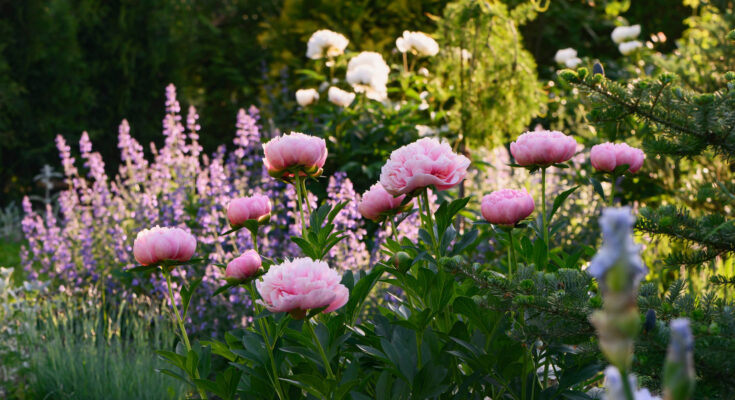Mistakes Everyone Makes When Growing Perennials In The Garden
We may receive a commission on purchases made from links.
Planting perennials is a wonderful way to add some color and visual appeal to your garden. Compared to many other types of plants, perennials are generally known to be low-maintenance. That’s because perennials are plants that continue coming back year after year – unlike annuals that only last for one season. Some even naturally grow in number when they return, filling out your garden for you.
While perennials are relatively low maintenance and there are plenty of benefits to adding them to your yard, you shouldn’t rush into planting them. Instead, it is essential to understand the various mistakes you could make that could threaten their health or have a negative impact on the aesthetics and flow of your yard. We’ve put together a list of some mistakes that people commonly make when planting perennials to help you understand what you shouldn’t do. We’ll also share some things that you should be doing instead to support healthy plants and maintain your yard.
Selecting the wrong plants for your hardiness zone
Just because you find a picture of a beautiful perennial, it doesn’t mean it will be the right choice for your yard. Ignoring your hardiness zone is a mistake that could result in your plants dying over the cold winter months. Hardiness zones, which the USDA establishes, break the country into different regions based on temperature minimums during the coldest months of the year. For example, if you live in Zone 5, which has an average minimum winter temperature of -20°F to -10°F, but plant a perennial that is only recommended for Zones 7 or above, which has an average minimum of 0°F to 10°F, it likely won’t survive.
So, instead of simply buying plants because you like how they look, it is imperative to know your hardiness zone and look for which zone(s) they are recommended for. If you live in a very cold climate, you’ll need to be very selective when choosing flowering perennials that can withstand the frigid winters. Fortunately, this information should be readily available on the plant packaging or through the retailer’s website. Generally speaking, if a perennial is being sold at a local nursery, it should be approved for your growing zone. However, it never hurts to verify this before making a purchase.
Overlooking soil quality and readiness
One of the most serious mistakes you can make when growing perennials is failing to consider the soil quality and whether it is ready to help your plants thrive. While all plants need quality soil to flourish, it’s especially important to get it right for perennials since they will be popping up in the same dirt patch for years to come. If the soil is subpar, it will only get worse over time, making it more and more difficult for the plant to grow and for you to remedy the situation after the fact. Generally speaking, perennials require well-draining soil with a slightly acidic to neutral pH (between about 6.0 and 7.0 is typically ideal).
So, how should you prep your soil for successful planting? You can’t know what to do for your soil if you don’t assess its needs. Start by performing a soil test, using a kit like the MySoil Soil Test Kit. This will provide you with information about the pH level, allowing you to make modifications as necessary. For example, if your soil is overly acidic, then you can raise the pH by adding lime (like this Garden Supply Organic Dolomite Lime) to it. Overly compact or clay soil also isn’t going to be ideal for perennials because it won’t allow sufficient drainage. Aerate overly compacted soils and incorporate peat moss or compost to help ensure proper drainage.
Overlooking sunlight needs
It is easy to make a mistake when choosing where to plant your perennials. If you don’t take their sunlight needs into consideration, you could inadvertently choose a location that won’t set them up for success. Their sunlight needs can differ, so it is best not to assume that they will all thrive under the same conditions. For instance, if you plant a perennial that requires a lot of sunlight in the shade, it may not remain healthy.
Before planting anything, the safest option will be to research the specific light needs of each one you want to add to your garden. With that in mind, we can share a few general pointers to help you out. The majority of perennials grow best when there is plentiful sunlight. For these plants, you’ll want to choose a location in the yard that receives a minimum of eight hours of direct sun. However, this is just a general rule. There are some plants — including the low-maintenance Chantilly lace — that do best when planted in the shade (or at least a location that is partially shaded throughout the day). Some other examples of perennials that prefer shade include hostas and ferns.
Planting too early or late in the season
Choosing the wrong time to plant your perennials is another mistake that you won’t want to make. If you plant at the wrong time, then your plants may not survive the cold winter months. However, there is no set date for planting perennials — it will depend on where you live, the climate, and the specific plant you want to grow.
Depending on where you live and which flowers you want to grow, early spring or fall are generally considered the best times to get your new perennials in the ground. If you would like flowers in your garden in late summer or early fall, plant your blooms in early spring. If you wait until too late in the season, you may stress the plants with temperatures that are too hot as they are just starting to take root. Similarly, if you are planning your spring flowers for the following year, plant them in early fall, at least six weeks before the first frost is scheduled to hit. This will give them a chance to develop their roots, and then they will go dormant as winter takes over. However, if you wait too long, the roots won’t be adequately established, and the plant might not survive the cold, icy, and snowy months ahead.
Planting them too close together
Planting perennials too close together is a mistake you should avoid for a variety of reasons. For instance, if your plants are crammed together, there won’t be adequate air circulation, which can lead to trapped humidity, which in turn can encourage powdery mildew. The fungal disease can result in plants getting covered with white splotches. If the disease progresses and becomes very severe, the affected leaves could end up yellowing, or even falling completely off the plant. But diseases aren’t the only reason you should avoid placing the plants too closely together. Keep in mind that they are going to grow, so you want to make sure they have enough space to spread out. If not, they could end up competing for sun and nutrients. It will also be difficult to prune the plants or check for pests if they’re right on top of one another.
So, how spaced out should they be? Sadly, the answer is not so cut and dry. Instead, it is crucial to consider how big the plant should be after it has finished maturing. The larger the plant at maturity, the more space you’ll need to give it in the garden. Shorter perennials (under two feet tall) should be separated by at least one foot of space. Plants that will grow to be three feet or taller will need more space — at least two to three feet between the perennials.
Not designing an attractive layout
One of the main reasons you’re planting perennials likely relates to aesthetics. They have the potential to enhance the beauty of your garden, but if you aren’t purposeful about what you plant where, you could end up with something that looks jumbled, messy, and uncoordinated.
There are several factors to consider when choosing plants and deciding the best way to lay them out. One thing to think about is bloom times. If all of your flowers bloom at the same time of the year, your garden will be very bright and vibrant during that period. However, it may look pretty dull and depressing before and after. Consider mixing some perennials that will bloom every autumn with those that open up during the spring or summer to keep your garden colorful for a greater portion of the year.
You’ll also want to consider color. Perennials often look best when they are placed in small groups of similar colors. For example, placing some perennials that bloom with gorgeous purple flowers in one section and others that have yellow or orange blossoms in another section can really make the vibrant colors stand out for a more appealing look. You also shouldn’t overlook other design elements, such as texture or height. Be careful to avoid planting a taller flower in front of a shorter one that no one will be able to see. Mix textures as well for a more varied and eye-catching look.
Overlooking the importance of hydrozoning
So, what is hydrozoning and how can it benefit your garden? Hydrozoning involves grouping plants based on their watering needs to ensure each one gets the right amount of moisture. Without it, some plants may be overwatered while others go thirsty.
To avoid this, start by identifying how much water each plant needs, and then group drought-tolerant plants together and thirsty blooms together. You want to avoid mixing them together since this will leave half of them perpetually unhappy. Next, choose planting locations that support each group’s needs. For example, avoid placing moisture-loving plants at the top of a slope, where water runs off quickly. The spot is a better match for perennials that can tolerate a little bit of drought. Meanwhile, the bottom of that slope, where water is likely to collect, may be the ideal location for perennials that have a greater need for moisture.
Over- or under-watering the plants
Hydrozoning your perennials can help with meeting their watering needs, but it will still be possible to over- or under-water these plants. Both of these mistakes can threaten the health of the flowers. If perennials don’t get enough water, they’re less likely to blossom and bloom. However, you shouldn’t go too far the other way and dump excessive amounts of water on your plants. Even if you don’t completely wash them away, providing them with too much water can result in shallow-rooted plants that aren’t going to grow to their full potential or hold up as well to various threats.
While each perennial may have its own specific needs, a good general rule is to water deeply but infrequently (about once per week). This encourages strong, deep roots, which helps plants become more drought-tolerant. However, if you water too frequently, the roots will never find the need to search deep into the soil for water and nutrients. Shallow-rooted plants are more likely to become damaged and will not hold up well to periods of drought or neglect.
Allowing weeds to compete with the perennials
Perennials need water, nutrients from the soil, and sunlight to thrive. One of the biggest threats to all of these essentials is weeds. If weeds grow close to your plants, they begin to compete for the same resources, taking away much of what the perennials need to thrive.
One of the most important things you can do to protect perennials from weeds is to monitor the garden frequently and act quickly to remove any that pop up. Hand pulling weeds early — before they have a chance to grow and develop thicker roots — can offer the greatest chance of success. You’ll be able to remove them before they have a chance to pull too many nutrients or really threaten the perennials.
If weeds have become more established or are taking over a larger area of your garden, then hand-pulling may not be the best solution. Instead, you might want to consider hoeing to more effectively remove larger swathes. Be careful using herbicides around perennials. Some products on the market are non-selective. Instead of killing just the weed, they’ll also kill any nearby plants.
Forgetting the mulch
Forgetting to mulch around the perennials you plant — or assuming that doing so is an unnecessary step — are both serious mistakes that you must be careful to avoid. Without mulch, the soil will dry out much more quickly, requiring you to water the plants more frequently. A lack of mulch will also make it more likely for weeds to pop up around the plants, hogging the essential nutrients in the soil. Moreover, without mulch, the perennials will be more susceptible to damage from lawn equipment such as string trimmers
Fortunately, avoiding this mistake is as simple as remembering to apply mulch around the new plants. The best time to do so is as soon as you’ve planted. Cover the full garden bed with a thick layer, leaving a few inches of space around each perennial’s base. Leaving this space ensures there is sufficient air circulation to avoid damage from pests or diseases.
Overlooking the importance of staking certain stems
Some perennials grow to be quite tall. Others have particularly heavy flowers. Neglecting to stake such plants could prove to be a serious mistake. When unstaked, a strong wind will be more likely to damage the perennial’s stem. Strong rains could also be a problem, potentially breaking the stems or the heavier head off. Plus, bowing heads can flop over on neighboring plants, not only creating a messy design but also blocking them from the sun.
Some examples of perennials that could benefit from being staked include dahlias, peonies, sweet peas, and lilies. The best time to attach the stakes to the stem is in the early spring. Not only will early placement help ensure that your plant is protected against the elements as soon as possible, but it will also give the plant plenty of time to grow through the support system. For example, if you use a trellis, the blooms will eventually grow through and around it, completely hiding it from view.
Deciding not to deadhead the plants
The satisfaction of seeing your perennials bloom after all the hard work you put into planting and caring for them is unmatched. However, just because they’ve bloomed doesn’t mean that your duties are complete until the following season. Instead, you need to routinely deadhead your plants, which means cutting off spent blooms before they seed. If you neglect to do so, you might be inadvertently preventing your plants from directing resources towards forming new growth.
When the spent flower stays on the plant, it will direct lots of its energy towards producing seeds. But when you deadhead it before it does so, that energy is freed up and can be diverted into developing deeper roots and new shoots. Some perennials will even redirect that energy towards blooming a second time for the season. A few of these double-bloomers include zagreb, hemerocallis, alchemilla, and astrantias.
The best way to deadhead a perennial will vary based on the specific flower. However, the general principle involves cutting back the old blooms to a leaf or lateral bud.



